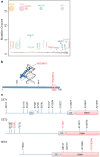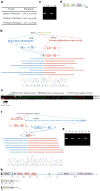Recurrent R-spondin fusions in colon cancer
- PMID: 22895193
- PMCID: PMC3690621
- DOI: 10.1038/nature11282
Recurrent R-spondin fusions in colon cancer
Abstract
Identifying and understanding changes in cancer genomes is essential for the development of targeted therapeutics. Here we analyse systematically more than 70 pairs of primary human colon tumours by applying next-generation sequencing to characterize their exomes, transcriptomes and copy-number alterations. We have identified 36,303 protein-altering somatic changes that include several new recurrent mutations in the Wnt pathway gene TCF7L2, chromatin-remodelling genes such as TET2 and TET3 and receptor tyrosine kinases including ERBB3. Our analysis for significantly mutated cancer genes identified 23 candidates, including the cell cycle checkpoint kinase ATM. Copy-number and RNA-seq data analysis identified amplifications and corresponding overexpression of IGF2 in a subset of colon tumours. Furthermore, using RNA-seq data we identified multiple fusion transcripts including recurrent gene fusions involving R-spondin family members RSPO2 and RSPO3 that together occur in 10% of colon tumours. The RSPO fusions were mutually exclusive with APC mutations, indicating that they probably have a role in the activation of Wnt signalling and tumorigenesis. Consistent with this we show that the RSPO fusion proteins were capable of potentiating Wnt signalling. The R-spondin gene fusions and several other gene mutations identified in this study provide new potential opportunities for therapeutic intervention in colon cancer.
Figures




Similar articles
-
Chromosome Engineering of Human Colon-Derived Organoids to Develop a Model of Traditional Serrated Adenoma.Gastroenterology. 2020 Feb;158(3):638-651.e8. doi: 10.1053/j.gastro.2019.10.009. Epub 2019 Oct 14. Gastroenterology. 2020. PMID: 31622618
-
RSPO fusion transcripts in colorectal cancer in Japanese population.Mol Biol Rep. 2014 Aug;41(8):5375-84. doi: 10.1007/s11033-014-3409-x. Epub 2014 May 22. Mol Biol Rep. 2014. PMID: 24847761
-
RSPO3 expands intestinal stem cell and niche compartments and drives tumorigenesis.Gut. 2017 Jun;66(6):1095-1105. doi: 10.1136/gutjnl-2016-311606. Epub 2016 Aug 10. Gut. 2017. PMID: 27511199 Free PMC article.
-
The role of R-spondin proteins in cancer biology.Oncogene. 2021 Nov;40(47):6469-6478. doi: 10.1038/s41388-021-02059-y. Epub 2021 Oct 18. Oncogene. 2021. PMID: 34663878 Free PMC article. Review.
-
Vitamin D and Wnt/beta-catenin pathway in colon cancer: role and regulation of DICKKOPF genes.Anticancer Res. 2008 Sep-Oct;28(5A):2613-23. Anticancer Res. 2008. PMID: 19035286 Review.
Cited by
-
Germline and somatic polymerase ε and δ mutations define a new class of hypermutated colorectal and endometrial cancers.J Pathol. 2013 Jun;230(2):148-53. doi: 10.1002/path.4185. J Pathol. 2013. PMID: 23447401 Free PMC article.
-
Rare coding variants and X-linked loci associated with age at menarche.Nat Commun. 2015 Aug 4;6:7756. doi: 10.1038/ncomms8756. Nat Commun. 2015. PMID: 26239645 Free PMC article.
-
The burden of faulty proofreading in colon cancer.Nat Genet. 2013 Feb;45(2):121-2. doi: 10.1038/ng.2540. Nat Genet. 2013. PMID: 23358219
-
The way Wnt works: components and mechanism.Growth Factors. 2013 Feb;31(1):1-31. doi: 10.3109/08977194.2012.752737. Epub 2012 Dec 21. Growth Factors. 2013. PMID: 23256519 Free PMC article. Review.
-
Capture Hi-C identifies the chromatin interactome of colorectal cancer risk loci.Nat Commun. 2015 Feb 19;6:6178. doi: 10.1038/ncomms7178. Nat Commun. 2015. PMID: 25695508 Free PMC article.
References
-
- Chin L, Andersen JN, Futreal PA. Cancer genomics: from discovery science to personalized medicine. Nature Med. 2011;17:297–303. - PubMed
-
- Siegel R, Ward E, Brawley O, Jemal A. Cancer statistics, 2011: the impact of eliminating socioeconomic and racial disparities on premature cancer deaths. CA Cancer J Clin. 2011;61:212–236. - PubMed
-
- Fearon ER. Molecular genetics of colorectal cancer. Annu Rev Pathol. 2011;6:479–507. - PubMed
-
- Wood LD, et al. The genomic landscapes of human breast and colorectal cancers. Science. 2007;318:1108–1113. - PubMed
Publication types
MeSH terms
Substances
Grants and funding
LinkOut - more resources
Full Text Sources
Other Literature Sources
Molecular Biology Databases
Research Materials
Miscellaneous

